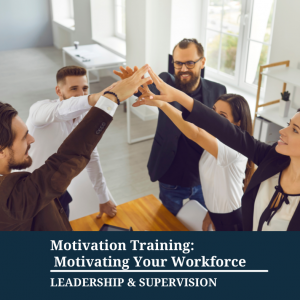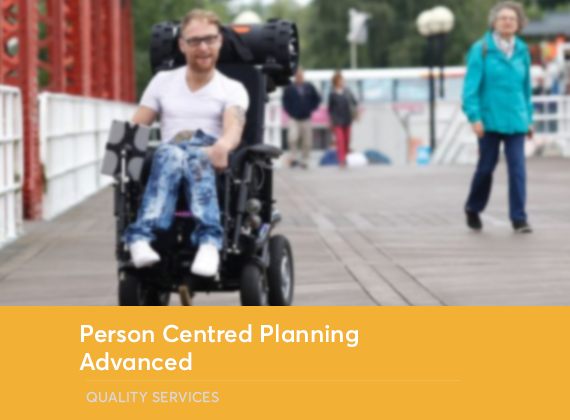-
Motivation Training: Motivating Your Workforce
€29.99To start this course, you will learn about some basic motivation theories. You will also learn about setting goals, identifying values, and ways to create a motivational climate. -
Problem Solving and Decision Making
€29.99In this course, you will learn a three-phase problem solving process that you can apply to any situation. You will also learn techniques for creative thinking, how to make good group decisions, and ways to follow up on and evaluate decisions. -
The Professional Supervisor
€29.99In this course, you will learn how to plan effectively, build a high-performing team, motivate employees, provide effective feedback, delegate, and manage conflict. You will also receive an introduction to several leadership theories, including John Adairs action-centered leadership model, Paul Hersey and Ken Blanchards Situational Leadership II model, and Velsofts signature leadership assessment. -
Workplace Health and Safety: The Supervisor’s Role and Responsibilities
€29.99At the end of this course you are going to be able to understand the employers and supervisors responsibilities for workplace health and safety and you will also learn about, and understand, the three rights of workers. You will learn about Health and Safety Committees, employee orientation checklists, health and safety training for employees, and the importance of communicating health and safety information. -
Safeguarding of Vulnerable Adults Training Part 1
Aims and Objectives of Programme Overview of Safeguarding Policy and HSE commitment to prevention of Abuse Indicators of Abuse Safeguarding links to HIQA Standards Increase staff knowledge and understanding of what is abuse and neglect Help staff to identify care practices that might lead to or contribute to abuse and neglect Help recognise abuse and neglect Understand and be able to define what is meant by the term abuse how and by whom abuse can take place be able to recognise different types or forms of abuse Be able to identify the possibility and or signs and symptoms a person been abused may display Be able to identify the factors and situations, including work and care practices, which can lead to abuse o Risk Management o Person Centeredness o Human Rights o Culture o Advocacy o Empowerment o Collaboration Discuss best practice strategies in scenarios where abuse may potentially occur Explore key considerations in recognising Abuse such as: Capacity Complaints Anonymous or historical complaints Know how to use the reporting system if you discover or suspect that abuse is taking place. Explain the actions that need to be taken if it is suspected that abuse is taking place -
Safeguarding of Vulnerable Adults Training Part 2
Objectives Discuss best practice strategies in scenarios where abuse may potentially occur Explore key considerations in recognising Abuse such as: Capacity Complaints Anonymous or historical complaint Explain how to use the reporting system and required actions if abuse is discovered or suspected Building Blocks for Safeguarding and Promoting Welfare Reflection #1 Prevention Strategies Case Scenario #1 Risk Management HSE Position on Risk Risk Factors Safeguarding Principles Human Rights Case Scenario #2 HIQA and Human Rights Person Centerdness Case Scenario #3 Case Scenario #4 Culture Safeguarding Policies Reflection #2 Advocacy Advocacy HIQA Standards Case Scenario #5 Empowerment Collaboration Considerations in Recognizing Abuse Recognizing Abuse Signs or Indications of Abuse Capacity Complaints Procedures for Reporting Abuse Responding to Concerns Safeguarding Team Organisational Arrangements Data/Information Making a Report -
Health Promotion and People with Intellectual Disabilities
€39.99Learning Outcomes Learners will be able to: 1 Explain how food is converted into energy and identify the factors that can affect the energy requirements of an individual: weight, height and exercise level 2 Outline current diet guidelines and explain the link between exercise and well-being 3 Demonstrate a basic knowledge of substance and drug abuse 4 Demonstrate an awareness about common illnesses in the population: Emphysema, COPD, Asthma, Diabetes, Heart Disease, etc 5 Identify health issues in the local community 2 6 Identify key agencies at local and national level e.g. medical, social, education, religious and sporting 7 Demonstrate the importance of being a positive role model in promoting a healthy lifestyle in others 8 Identify ways to facilitate change through creative means 9 Identify local resources i.e. funding, key personnel, facilities, etc 10 Identify tasks required for successful implementation of a planned event e.g. design information sheet, booking event, guest speaker 11 Use creative means to promoting healthy living and be able to motivate people (e.g. staff, clients, etc) 12 Adhere to budget guidelines 13 Review of set targets and identifying key issues of a planned event 14 Evaluate their own lifestyle choices 15 Appraise the need for a holistic (mind/body/spirit) approach to wellbeing 16 Set health promotion targets to promote a healthier lifestyle 17 Develop a health promotion event relevant to the local community 18 Demonstrate understanding of how best to motivate people 19 Know how to empower the individual in the local community i.e. education, access to resources, etc 20 Organise a healthy living event e.g. relevant seminar, food demonstration, hike, walk, exercise/dance/yoga class 21 Delegate responsibilities to team members as appropriate and supervise team members as required 22 Identify possible solutions and make recommendation for implementation on future events. -
Positive Behaviour Support Advanced
The Aims of this module are to: Understand the model of positive behaviour support as applied to people with intellectual disability who present with behaviour r Acquire knowledge of the multi-elements of positive behaviour support plans Develop skills in carrying out a comprehensive behavioural assessment and recording the information gathered Acquire skills in completing a functional analysis of target behaviours Develop the ability to design a multi-element Positive Behaviour Support plan incorporating person centred goals and promoting community inclusion Develop skills in monitoring and evaluating the effectiveness of the Positive Behaviour Support plan -
Person Centered Planning Advanced
Module 1 Historical Perspective Module 2 What is Person Centred Planning? Module 3 Legal Aspects Module 4 Communication and Person Centred Planning Module 5 Models of Support Module 6 Person Centred Planning Tools Module 6 Making PCP a Reality Module 7 Writing a PCP Plan Module 8 Supporting Risk Taking Approaches Module 9 Role of Organisation -
Collaboration
€29.99After completion of this course, you should understand the definition of collaboration, what it takes to work collaboratively with your colleagues and the advantages of collaboration. Obstacles to collaboration will be explored, and how to develop strategies to improve a collaborative work environment. As well, you will know the six steps to make collaboration work, and the difference between collaboration, cooperation and teamwork. -
Creating a Top-Notch Talent Management Program
€29.99In this course, you will learn about the various aspects of talent management, including performance management, succession planning, talent management programs, employee development strategies, and employee engagement plans. -
Business Succession Planning: Developing and Maintaining a Succession Plan
€29.99This course will teach you how to develop and maintain a succession plan with the SUCCESS model, which includes developing a system, identifying resources, creating risk assessments, developing action plans, implementing those plans, and evaluating the results. -
Customer Service Training: Critical Elements of Customer Service
€29.99This course is all about the critical elements of customer service: a customer service focus that is defined within, and given life by, your organization. In order to be successful, this focus must be reinforced every day, measured, and improved upon. -
Networking for Success
€29.99In this course, you will learn how to identify opportunities, create a positive first impression, develop a memorable intro, start conversations, shake hands well, handle business cards, manage sticky situations, follow up with others, and organize your network. Youll also learn how to network in online spaces, such as LinkedIn, Twitter, and Facebook. -
Public Relations Boot Camp
€29.99In this course, you will learn how to determine the type of information required in a particular situation, ways to approach PR strategically, how to create compelling releases, and techniques for managing media relations. -
Conducting Effective Performance Reviews
€29.99This in-depth course will cover the entire performance management process, various types of performance reviews, goal setting, feedback strategies, coaching tips, techniques for handling performance problems, and ways to maintain performance. -
Emotional Intelligence
€29.99This course will introduce you to the history of emotional intelligence and what its all about. Youll explore the most popular theories, including the EI blueprint, Martin Seligmans ABCs of optimism, the VALUE and SOLER techniques, Ekmans seven basic emotions, and Plutchiks wheel. Youll also explore your personal values and vision statement to help guide you in your emotional intelligence development. -
Budgets and Managing Money
€29.99To start this course, you will review the fundamentals of finance (including basic terms, generally accepted accounting principles, and financial roles in an organization). Then, you will learn about different types of budgets and a six-step budgeting process. You will also learn how to monitor budgets, perform basic ratio analysis, and compare investment opportunities. -
Performance Management: Managing Employee Performance
€29.99In this course, you will learn about the Shared Management Model, which helps the manager transfer motivation and responsibility for results to the employee. This course will cover all three phases of the model: preparing the employee for the job, motivating them to do it, and evaluating their performance. -
Self-Leadership
€29.99In this course, you will explore the four pillars of self-leadership: knowing who you are, knowing what you do, knowing what you need to learn, and using what you know. -
Creative Thinking and Innovation
€29.99In this course, you will identify ways to develop your creative side and build a creative environment. Youll also learn a basic problem-solving process, individual creative thinking tools (such as the RAP model, shoe swap technique, mind mapping, metaphors, and toys), and team-based creative thinking tools (such as brainstorming, brainwriting, rolestorming, the stepladder technique, and slip writing). -
Personal Brand: Maximizing Personal Impact
€29.99In this course, youll learn what a brand is and how you can leverage it to make a personal impact. Youll define, design, and plan the interior elements of your brand (such as your confidence level and approach to others) as well as the exterior elements (such as how you dress and act). Youll also learn supporting skills, such as setting goals, communicating effectively, building your credibility, managing difficult conversations, influencing others, and speaking in public. -
Workplace Violence: How to Manage Anger and Violence in the Workplace
€29.99In this course, you will learn a nine-stage plan to help organizations prevent violence. You will also learn how to respond to violent incidents, manage anger, and implement design and hiring practices that will keep employees safe.






























